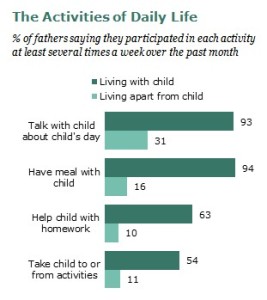Fatherlessness in families has been on the rise since 1960, and now is the situation in one-third of homes–meaning that 24 million American children do without their fathers.
Among the stock-and-trade activities documented to be missing from the lives of fatherless children are talking about the child’s day, sharing meals, helping with homework and going to and coming from activities.
Statistics show marked disadvantages caused by fatherlessness. Fatherless children account for  more youth suicides, runaways and dropouts, and are two to three times as likely to have behavior disorders, experience poverty, chemical abuse, institutionalization and imprisonment, child abuse and child neglect. Criminal behavior such as anger-related rape is higher for those who were fatherless.
more youth suicides, runaways and dropouts, and are two to three times as likely to have behavior disorders, experience poverty, chemical abuse, institutionalization and imprisonment, child abuse and child neglect. Criminal behavior such as anger-related rape is higher for those who were fatherless.
However, the greatest losers when fathers are not present are daughters. The prospects for family of fatherless daughters are very different from those of daughters with families.  Fatherless daughters are 711 percent more likely to have kids as teenagers, 164 more likely to have a pre-marital birth, and 92 percent more likely to get divorced.
Fatherless daughters are 711 percent more likely to have kids as teenagers, 164 more likely to have a pre-marital birth, and 92 percent more likely to get divorced.
Why fatherlessness has increased from around 8 percent in 1960 to around one third in the 2010s is not completely understood, but fathers have cited two main reasons. The most commonly cited is “non-marital relationships and divorce.” The second is incarceration, which accounts for 7.3 of the 24 million fatherless American children.
By Day Blakely Donaldson
